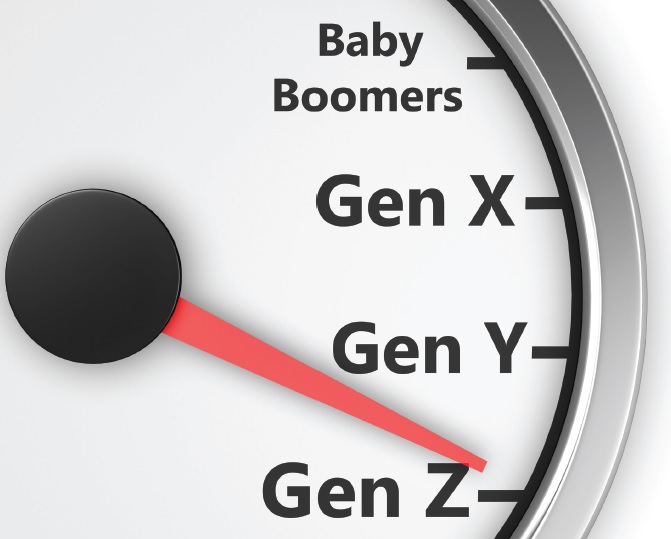
A Multigenerational Perspective
BY DENNIS HEALY
It’s not uncommon to refer to the “workforce” collectively. But when it comes to employee benefits, it’s critical to recognize that this collective comprises a diverse group of individuals, each with their own needs, challenges and expectations.
Today, employers have as many as four generations working together — from the persistent baby boomers to the often-overlooked GenXers, the heralded millennials to the Gen Z newcomers. This generational diversity — coupled with the harrowing reality of the post-pandemic “Great Resignation” — has prompted many brokers to help their clients go beyond attractive core benefit offerings and craft agile programs to serve their employees’ disparate and evolving needs. A better understanding of each generation’s distinct concerns, behaviors and preferences — as well as those they share — may help your clients stem the tide, helping them retain and recruit valued employees.
Baby Boomers
The oldest of our working generations, baby boomers (born in 1946 to 1964) have traditionally comprised a large part of the workforce. There were concerns that, as they hit retirement age, the ‘gray tsunami’ might negatively affect businesses. But perhaps prompted by the financial impact of the 2008-09 recession, the anti-ageism movement or simply because they wanted to, this ‘live-to-work’ generation has retired at a slower rate than anticipated, enabling companies to retain and transition the institutional knowledge they feared losing.
Among the benefits that still-employed boomers value most are quality medical, dental and vision insurance. This is no surprise, since 60% of this generation is managing a chronic health condition. And not unlike other generations, baby boomers also favor allied well-being perks, like gym membership reimbursements. Giving boomers incentives to stay active as they age is important for them to maintain both their physical and mental health.
They also share with fellow employees of all ages a focus on financial wellness, but with the more immediate term need for retirement security.
Top generation tip: Because boomers are keen on working past traditional retirement age, at least in a part-time role, the transition may make them ineligible for many benefits that are only available to full-time employees, like group health plans. Employers might consider offering individual health plans as an option to ensure continuation of medical coverage.
Generation X
Sandwiched between two much larger and high-profile generations
(boomers and millennials), Gen X can be somewhat overlooked. Born between 1965 and 1980, Gen X represents about one-third of the U.S. workforce and is the second largest employment group in the country.
And their contribution is significant. They’ve not only become well-established in their careers and are pivotal to their employers, but they are also the working generation most likely to be caring for both their children as well as aging loved ones.
Gen Xers value customizable benefits that recognize and support work-life balance, offer caregiving options, workplace flexibility (like remote work or flex time) and paid-time off to help them effectively meet their professional and personal responsibilities.
According to PwC, more employees than ever before report that finances are the top cause of their stress. For Gen X employees, worries about their financial well-being are tied largely to student debt, a reflection of their own student loans and those for their children’s education.
In addition to student loan assistance, this generation values retirement benefits and tax-advantaged programs. Health Savings Accounts (HSAs) or Dependent Care Flex Spending Accounts (DC FSA) help preserve their savings. On a similar note, at ARAG® Legal, our analysis indicates that this demographic (median age 48) is the most likely to elect legal insurance as part of their benefits packages as a means to protect themselves and their families.
Top generation tip: Convenience is essential for this stretched thin employee group. Helping employers prioritize flexibility in their benefit offerings will go a long way in keeping Gen Xers — and their fellow employees — engaged.
Millennials
Otherwise known as Gen Y, millennials are the largest segment of the population at 87 million strong. They overtook boomers as the largest cohort in the workforce in 2016. Forecasts say that millennials will make up 40% of the global workforce by 2025. For many employers, the sheer size of this generation carries significant weight and makes meeting their needs a high priority.
Millennials are more career mobile — changing jobs more often than any generation. A LinkedIn study found that millennials will change jobs an average of four times in their first decade out of college, compared to about two job changes by Gen Xers in the same period. Because Gen Y prioritizes benefits over pay, employers are wise to provide them an ability to mix and match benefits to keep them engaged, much like their Gen X counterparts.
An unfortunate reality is that nearly 15 million millennials carry student debt, more than any other generation, making loan assistance from their employer highly valued. In addition, many millennials (born between 1981 and 1996) have started families or are planning to, so offering fertility benefits, family leave, dependent care assistance programs and workplace flexibility can be very appealing.
Top generation tip: Millennials have also adopted an “anything can happen” mindset and value benefits that bring them peace of mind — from top-ranked healthcare insurance to pet and legal insurance. Forty-one percent of millennials surveyed have purchased legal insurance to help protect them as they navigate important life decisions. And almost a third (31 percent) of millennial pet owners report having pet insurance, compared to GenXers and Boomers (15 percent and 8 percent, respectively).
Generation Z
The youngest employed generation, born between 2001 and 2020, Gen Z is just beginning to enter the workforce. While still new to the workplace, this group appears to be ambitious and with an eye to their future. Nearly two-thirds (64%) say career growth opportunities are a top priority when looking for a job, which speaks to the need for professional development, continuous learning and mentoring.
In a recent Monster survey, 83% of Generation Z respondents said that a company’s values, particularly their commitment to diversity and inclusion, was an important factor when choosing where to work.
Initially, Gen Z didn’t fully appreciate workplace benefits, but since the COVID-19 pandemic, they mirror the wants and needs of millennials, their slightly older counterparts. And like Gen Y, they are likely to seek out a new job in order to find better benefits.
Gen Zers are likely to consider supplemental benefits as part of total compensation and value offerings like flexible paid time off (PTO), tuition reimbursement, pet insurance and accident insurance.
Top generation tip: Gen Z is much more open and accepting of mental health care, compared to older generations. Employers should place more emphasis on benefits that support well-being, like Employee Assistance Programs and resiliency training and stress management programs.
Across the board
As a broker, you can help your clients meet the challenges of crafting a benefits program that addresses the myriad needs of today’s multigenerational workforce. Across the workforce, employees are looking for added flexibility — enabling them to match their benefit selections to their unique situation. Delivering a customizable benefits structure that can accommodate individual needs is essential in helping employees feel heard and valued, regardless of their stage in life.

DENNIS HEALY is a member of the ARAG executive team. Connect with him on LinkedIn: https://www.linkedin.com/in/dennishealylinkedin
